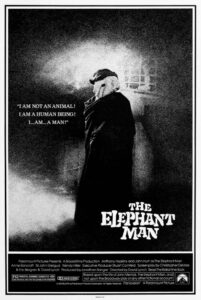The Elephant Man Review
The film I chose to watch was Elephant Man. It is a 1980 film produced by Jonathan Sanger and Mel Brooks (uncredited by choice). The film is based on two books, The Elephant Man and Other Reminiscences by Frederick Treves and The Elephant Man: A Study in Human Dignity by Ashley Montagu, plus some creative liberties. The basic premise of the story is that Dr. Treves find John Merrick (Joseph Merrick in real life) in a circus show because he has birth defects that disfigures him. To make money he uses his condition in the act called “The Elephant Man.” Dr. Treves talks with Merrick and learns that he is quite intelligent and kind. Merrick becomes the focus of London society, even befriending an actress before he dies.
THEMES:

Disability vs Humanity: The first big theme would be the understanding of humanity in disability. By this I mean that, then and now, people tend to forget that there is a human like you or me behind the disabled body. Just because John was different, did not mean that he should have been a spectacle or treated as an simple minded person. For the first half of the movie, each person that meets John, including Dr. Treves, thinks him to be stupid and is later shocked by his ability to talk. Circus freaks, as they were called, were people that were just different than what society deemed as normal. This only applied to people with visible differences or issues.
Class divide: Another theme is that treating someone as a spectacle can take multiple forms and can be just as cruel in their own ways. As seen a bit in the film, the idea of Human Zoos held public popularity until recent years. This film exposes just a small extent to how poorly these people were treated. John was abused in all forms and may not have received the worst of the treatment. Class comes into this because when John is treated as a circus freak, this is mostly viewed by the lower classes and is more blunt to his face. However, when the upper classes learn about John being at the London hospital and being deemed as intelligent, they are running to see him with presents. They talk about how surprised that someone as ugly as him with his background could be so smart. Many people do this still by saying “you are smart for a…” as a backhanded compliment.
KEY MOMENTS:
40:00-41:45
This extremely short, but immensely important, moment in the film shows John was able to speak his own name. Him speaking his own name, proves he hears and understands everything happening around him, he is just mute because of the trauma he has endured. It is also a struggle for him, at first, to form the words meaning that it has probably been a long time since John had last spoken.
1:08:00-1:12:00
In this next seen, we are able to see the upper classes of London society flock to see John as he is said to be so smart. The first visitor to see John is Mrs. Kendal, a well-known actress of the theater, who truly cares for John. Mrs. Kendal reads lines from a play with John and connects deeply with him which is the one act that makes the rest of London society interested in him. Dr. Treves now asks if John is a spectacle again in a different location.
TEACHING AND LEARNING:
If I were to use this film in an education context, I think this would be great for the discussion around the history of both mental health and disability history but in a social context. This story pokes at the different class reaction to John which included the doctors and nurses. I would show this as an example of historically accurate in the basic sense. By this I mean that all films (that are not documentaries) are a bit overdramatic for the sake of a story. John does represent a real person that made an impact on society, but we will never know all the details. This means that some conversations and small details, are creative liberties. But again, the basic premise of the story exists. I would start to poke at questions like “what did John say to get the upper classes to pay attention to him?” and “What were things that john did that were judged at first and seen as special later?” I would also like learners to ask questions about the one project that John makes which is destroyed later. The paper church, for example, has layers of significance including the place and the item itself.